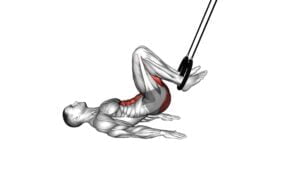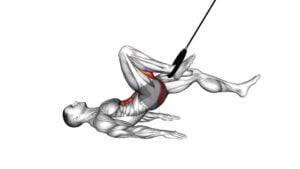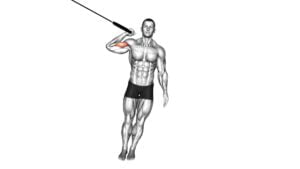Ring Leg Curl – Video Exercise Guide & Tips

Are you looking for an effective leg exercise that can be done at home? Look no further than the ring leg curl!
Watch This Exercise Video
This exercise targets your hamstrings and glutes, helping to strengthen and tone your lower body.
In this video exercise guide, we'll show you the proper technique and provide tips to increase the intensity.
Get ready to feel the burn and achieve your fitness goals with the ring leg curl!
Key Takeaways
- Ring leg curls target the hamstrings and glutes, strengthening and toning the lower body.
- They engage multiple muscle groups and allow for a greater range of motion.
- Ring leg curls improve balance and stability.
- To increase intensity, try advanced variations such as single-leg curls or different foot positions.
Benefits of Ring Leg Curl
Experience the numerous benefits of the ring leg curl exercise. Ring leg curl variations are an effective way to target your hamstring muscles and improve their strength and flexibility. The ring leg curl exercise engages multiple muscle groups, including the hamstrings, glutes, and lower back, making it a great addition to your lower body workout routine.
One of the key benefits of ring leg curl variations is that they allow for greater range of motion compared to traditional leg curl machines. This increased range of motion helps to activate the muscles throughout their full length, leading to better overall muscle development. Additionally, ring leg curl variations also engage the stabilizer muscles in your core, helping to improve your balance and stability.
To maximize the benefits of ring leg curl variations, it's important to incorporate proper stretching into your routine. The best stretches for hamstring muscles include the standing hamstring stretch, lying hamstring stretch, and seated hamstring stretch. These stretches help to improve flexibility and prevent injuries during the ring leg curl exercise.
Equipment Needed for Ring Leg Curl
To perform the ring leg curl exercise, you'll need a set of rings or suspension straps. These pieces of equipment are essential for properly executing the exercise and targeting your leg muscles effectively. With the rings or suspension straps, you can adjust the height and position of the rings to suit your needs and fitness level.
Here are a few alternatives to the ring leg curl that you can consider:
- Swiss ball hamstring curl: This exercise involves lying on your back with your feet on a Swiss ball and curling your legs towards your glutes. It's a great alternative if you don't have access to rings or suspension straps.
- Resistance band leg curl: Using a resistance band, anchor one end to a stable object and loop the other end around your ankles. Lie on your stomach and curl your legs towards your glutes against the resistance of the band.
- Slider hamstring curl: This variation requires sliders or towels placed under your feet. From a plank position, slide your feet towards your glutes, engaging your hamstrings.
Remember to choose the variation that suits your fitness level and equipment availability. These alternatives provide similar benefits to the ring leg curl and can be incorporated into your leg workout routine.
Proper Technique for Ring Leg Curl
To properly execute the ring leg curl exercise, follow these steps.
- Begin by attaching the rings to a stable anchor point, such as a pull-up bar or sturdy beam. Once the rings are secure, position yourself facing the ground, with your arms extended and your feet in the rings.
- Engage your core and glutes to maintain a neutral spine throughout the exercise.
- From this starting position, bend your knees and bring your heels towards your glutes, using the muscles in the back of your thighs to initiate the movement.
- Avoid swinging or using momentum to complete the exercise, as this can lead to improper form and reduced effectiveness. Keep the movement controlled and deliberate, focusing on the contraction of your hamstrings.
- Be sure to avoid common mistakes such as arching your back or letting your hips drop.
There are also variations of the ring leg curl that you can try, such as single-leg curls or adding ankle weights for added resistance. By incorporating these variations, you can target different muscles and increase the intensity of your workout.
With the proper technique and variations, you can maximize the benefits of the ring leg curl exercise.
In the next section, we'll discuss tips for increasing the intensity of the ring leg curl.
Tips for Increasing Intensity of Ring Leg Curl
To increase the intensity of your ring leg curl, try performing the exercise with a slower tempo and a higher number of repetitions. This will challenge your muscles and help you achieve better results. Here are some tips to help you increase the intensity of your ring leg curl:
- Tips for Advanced Variations:
- Try performing the ring leg curl with one leg at a time. This will engage your core and glutes even more.
- Incorporate resistance bands into your routine. Attach the bands to the rings and perform the leg curl while pulling against the resistance.
- Experiment with different foot positions. You can try pointing your toes or flexing your feet to target different muscle groups.
- Alternatives to Ring Leg Curl:
- If you don't have access to rings, you can try performing the leg curl using a stability ball. Lie on your back with your feet on the ball and lift your hips off the ground as you curl the ball towards your glutes.
- Another alternative is the seated leg curl machine at the gym. This machine allows you to adjust the weight and focus solely on the leg curl movement.
Common Mistakes to Avoid During Ring Leg Curl
Avoid these common mistakes during ring leg curl to ensure proper form and maximize the effectiveness of your workout.
One common mistake people make is using momentum to swing their legs up instead of relying on their hamstring muscles. It's important to control the movement and engage the hamstrings throughout the exercise.
Another mistake isn't maintaining a straight body position. Keep your body in a straight line from head to toe, with your core engaged and your shoulders pulled back. This will help to prevent any unnecessary strain on your lower back.
Additionally, avoid lifting your hips too high during the exercise. This can put excessive stress on your lower back and take the focus away from the hamstrings. Instead, focus on keeping your hips level with your body throughout the movement.
Lastly, ensure that you're using the correct grip on the rings. Place your hands on the rings with palms facing down and thumbs wrapped around for a secure grip.
Frequently Asked Questions
How Many Sets and Reps Should I Do for the Ring Leg Curl Exercise?
For optimal training frequency, it's recommended to do 3-4 sets of ring leg curls. Aim for 8-12 reps per set, focusing on maintaining proper form and control throughout each repetition.
Beginners can modify the exercise by using a resistance band or a partner to assist in the movement.
Gradually increase the intensity and number of sets as you get stronger.
Remember to listen to your body and adjust as needed.
Can I Do the Ring Leg Curl Exercise if I Have Knee Pain or Injury?
If you have knee pain or injury, it's important to take precautions when doing the ring leg curl exercise. There are modified leg curl exercises that can be more suitable for individuals with knee issues.
It's crucial to listen to your body and not push through any pain. Consulting with a healthcare professional or a certified trainer can provide you with specific modifications and recommendations to ensure you're performing the exercise safely and effectively.
Is It Normal to Feel Discomfort or Tightness in the Hamstrings During the Ring Leg Curl Exercise?
Feeling discomfort or tightness in your hamstrings during the ring leg curl exercise is normal. To relieve hamstring tightness, try incorporating stretching techniques like static or dynamic stretching before and after your workout.
Additionally, warming up properly before performing the ring leg curl can help prevent discomfort in the hamstrings. Engage in a light cardio activity and perform dynamic stretches specific to the hamstrings to prepare your muscles for the exercise.
Can I Use a Resistance Band Instead of Rings for the Leg Curl Exercise?
Yes, you can use a resistance band as an alternative to rings for the leg curl exercise. While rings provide additional instability, using a resistance band still targets your hamstrings effectively.
The benefit of using rings is that they engage your core and stabilizer muscles more, leading to a greater overall workout. However, if you don't have access to rings, a resistance band is a suitable substitute that can still help you strengthen your hamstrings.
Are There Any Alternative Exercises That Target the Same Muscles as the Ring Leg Curl?
Looking for alternative exercises that target the same muscles as the ring leg curl? There are a few options you can try.
One modification is the glute bridge, which activates your hamstrings and glutes.
Another alternative is the stability ball hamstring curl, where you lie on your back and curl the ball towards your glutes.
These exercises can provide similar benefits to the ring leg curl and help strengthen your lower body.
Conclusion
In conclusion, the ring leg curl is an effective exercise that targets the hamstrings and glutes. By using rings instead of traditional equipment, it engages more stabilizer muscles and improves overall strength and stability.
Proper technique and gradually increasing intensity are key to maximizing the benefits of this exercise. Avoiding common mistakes, such as using momentum or not maintaining control, is crucial for safety and effectiveness.
Incorporating the ring leg curl into your workout routine can help enhance lower body strength and performance.

Author
Years ago, the spark of my life’s passion ignited in my mind the moment I stepped into the local gym for the first time. The inaugural bead of perspiration, the initial endeavor, the very first surge of endorphins, and a sense of pride that washed over me post-workout marked the beginning of my deep-seated interest in strength sports, fitness, and sports nutrition. This very curiosity blossomed rapidly into a profound fascination, propelling me to earn a Master’s degree in Physical Education from the Academy of Physical Education in Krakow, followed by a Sports Manager diploma from the Jagiellonian University. My journey of growth led me to gain more specialized qualifications, such as being a certified personal trainer with a focus on sports dietetics, a lifeguard, and an instructor for wellness and corrective gymnastics. Theoretical knowledge paired seamlessly with practical experience, reinforcing my belief that the transformation of individuals under my guidance was also a reflection of my personal growth. This belief holds true even today. Each day, I strive to push the boundaries and explore new realms. These realms gently elevate me to greater heights. The unique combination of passion for my field and the continuous quest for growth fuels my drive to break new ground.







